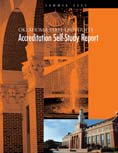The Self-Study Process
An institutional self-study was undertaken at OSU in preparation for the accreditation site visit from the Higher Learning Commission (HLC) of the North Central Association on September 26-28, 2005. Faculty, administrators, staff, and students studied the university in an effort to assess whether current policies, plans, and practices ensure fulfillment of the mission and the established accreditation criteria.
A director for the process was identified in late 2002. Early in 2003, representatives from major university areas, such as assessment, academic affairs, student affairs, institutional research, and enrollment management identified facuty leaders to chair the criterion groups. The HLC was developing new accreditation criteria, and it was essential to identify some primary steering committee members to study the new criteria and attend the HLC meeting in March 2003 to learn about the new criteria statements, core components, and patterns of evidence.
The Accreditation Steering Committee0.48 is a set of interactive teams0.49 engaged in the numerous tasks of the self-study process and report production. The core team of the steering committee consists of two groups: the representatives who provide support from major units and the faculty leaders who serve as criterion chairs. By early in the fall semester of 2003, the core team was in place, and membership in the various criterion teams was under consideration. The criterion teams, consisting mainly of faculty, were directed to study the criteria and identify examples of evidence to indicate that OSU satisfies the core components for each criterion. Care was taken to involve membership from many units over various colleges. A group was formed for each criterion, and two groups were formed for the broad criterion four. These criterion teams have interacted with the core team through the chairs of the respective criterion groups.
The main work of the criterion groups occurred within the academic year 2003-2004.0.50 They surveyed, interviewed, and gathered data to develop the evidence to indicate that the new criteria were fulfilled. The processes that the various groups utilized to develop the materials differed depending on the size of the group and the magnitude of the task. Criterion teams one and two were reasonably small groups with only five to six members, and their activities were parallel to the activities of the strategic planning process initiated through the Office of the President. Those two groups tended to work as units on their evidence gathering. The other criterion groups had more members and after initial discussions, tended to work in subgroups of two or three on specific core components.
Over the summer of 2004, writings, called Source Writings, developed from the groups and filtered through the chairs, were provided to the director. The source writings were circulated to other members of the steering committee and the self-study writer and were made available to the campus community through the accreditation website.0.51
During the second year of the self-study, the activities shifted to the writing of the self-study report itself. Three additional teams fulfilled specific needs during the writing process. A writing team with an appointed writer, web specialist, and design expert also included campus leaders from faculty, administration, and staff. A group of administrators, the Readers' Group, was organized specifically to incorporate administrative assistance throughout the development of the self-study report. Students were included on each criterion team to review the group's writing and participate in the preparation of the report and self-study events; these students were the initial members of the student team.
The task of writing the self-study report was organized into three preliminary drafts with a final draft to be presented to the HLC. At the beginning of the writing process, the Source Writings, the materials produced by the criterion teams, were disseminated to all teams of the steering committee and were placed on the website. Once the writer produced a first draft, questions, needs, and requests associated with that draft were circulated back to the core and writing teams. With input from those two teams, individuals were identified to respond to further information requests. The responses were returned to the director who then cycled that information back to the writer, the teams, and the website.
For each successive draft of the self-study report, the content and the presentation were discussed and adjusted through the process of multiple teams reviewing the material. The director served as a conduit for both communication and documents to facilitate effective interactions between and within the teams.
During the spring of 2005, the draft versions of the self-study report were available on the accreditation website. On- and off-campus constituents had the opportunity to read and respond to the report. Public events during this time, including lunches, receptions, and presentations, were used to generate discussion about the self-study, resulting report, and upcoming site visit. Listserv messages to faculty and staff informed the general university community about the accreditation process.
The last team added to the steering committee was the hospitality team. This group will provide hosts for the site visit and also provide a platform for student activities in the months leading up to the site visit.
Footnotes
Self-Study Process
- 0.48 - Appendix G.1 Accreditation Steering Committee ▲
http://accreditation.okstate.edu/RR/selfstudy/steeringcommittee/ - 0.49 - Diagram of Steering Committee Team Structure and Organization ▲
http://accreditation.okstate.edu/RR/selfstudy/committeestructure/ - 0.50 - Appendix G.2 Timeline for Self-Study ▲
http://accreditation.okstate.edu/RR/selfstudy/timeline/ - 0.51 - Accreditation Website ▲
http://accreditation.okstate.edu/
Additional Material
These documents describe the structure of the Accreditation Steering Committee and the self-study timeline. A summary of the process, along with the complete membership and a diagram of the interactive team structure of the committee are included.


